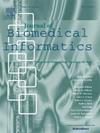RoBIn:基于变压器的机器阅读理解偏差风险推理模型
IF 4.5
2区 医学
Q2 COMPUTER SCIENCE, INTERDISCIPLINARY APPLICATIONS
引用次数: 0
摘要
目的:科学出版物对于揭示见解、测试新药和告知医疗保健政策至关重要。评估这些出版物的质量通常涉及评估其偏倚风险(RoB),这是传统上由人工审稿人执行的任务。这项工作的目标是创建一个数据集并开发模型,以便在临床试验中自动评估RoB。方法:我们使用Cochrane系统评价数据库(CDSR)的数据作为基础事实,标记PubMed的开放获取临床试验出版物。这个过程使我们能够开发专门用于机器阅读理解和RoB推理的训练和测试数据集。此外,我们创建了基于提取(RoBInExt)和生成(RoBInGen) transformer的方法来提取相关证据并有效地对RoB进行分类。结果:RoBIn在各种环境下进行了评估,并以最先进的方法为基准,包括大型语言模型(llm)。在大多数情况下,表现最好的RoBIn变体超过了传统的机器学习和基于llm的方法,实现了0.83的AUROC。结论:本研究通过引入RoBIn来解决临床试验中的RoB评估问题,RoBIn是两个基于transformer的RoB推理和证据检索模型,其性能优于传统模型和llm,显示了其在提高临床研究评估效率和可扩展性方面的潜力。我们还引入了一个自动注释的公共数据集,可用于未来的研究,以增强自动化RoB评估。本文章由计算机程序翻译,如有差异,请以英文原文为准。

RoBIn: A Transformer-based model for risk of bias inference with machine reading comprehension
Objective:
Scientific publications are essential for uncovering insights, testing new drugs, and informing healthcare policies. Evaluating the quality of these publications often involves assessing their Risk of Bias (RoB), a task traditionally performed by human reviewers. The goal of this work is to create a dataset and develop models that allow automated RoB assessment in clinical trials.
Methods:
We use data from the Cochrane Database of Systematic Reviews (CDSR) as ground truth to label open-access clinical trial publications from PubMed. This process enabled us to develop training and test datasets specifically for machine reading comprehension and RoB inference. Additionally, we created extractive (RoBInExt) and generative (RoBInGen) Transformer-based approaches to extract relevant evidence and classify the RoB effectively.
Results:
RoBIn was evaluated across various settings and benchmarked against state-of-the-art methods, including large language models (LLMs). In most cases, the best-performing RoBIn variant surpasses traditional machine learning and LLM-based approaches, achieving a AUROC of 0.83.
Conclusion:
This work addresses RoB assessment in clinical trials by introducing RoBIn, two Transformer-based models for RoB inference and evidence retrieval, which outperform traditional models and LLMs, demonstrating its potential to improve efficiency and scalability in clinical research evaluation. We also introduce a public dataset that is automatically annotated and can be used to enable future research to enhance automated RoB assessment.
求助全文
通过发布文献求助,成功后即可免费获取论文全文。
去求助
来源期刊

Journal of Biomedical Informatics
医学-计算机:跨学科应用
CiteScore
8.90
自引率
6.70%
发文量
243
审稿时长
32 days
期刊介绍:
The Journal of Biomedical Informatics reflects a commitment to high-quality original research papers, reviews, and commentaries in the area of biomedical informatics methodology. Although we publish articles motivated by applications in the biomedical sciences (for example, clinical medicine, health care, population health, and translational bioinformatics), the journal emphasizes reports of new methodologies and techniques that have general applicability and that form the basis for the evolving science of biomedical informatics. Articles on medical devices; evaluations of implemented systems (including clinical trials of information technologies); or papers that provide insight into a biological process, a specific disease, or treatment options would generally be more suitable for publication in other venues. Papers on applications of signal processing and image analysis are often more suitable for biomedical engineering journals or other informatics journals, although we do publish papers that emphasize the information management and knowledge representation/modeling issues that arise in the storage and use of biological signals and images. System descriptions are welcome if they illustrate and substantiate the underlying methodology that is the principal focus of the report and an effort is made to address the generalizability and/or range of application of that methodology. Note also that, given the international nature of JBI, papers that deal with specific languages other than English, or with country-specific health systems or approaches, are acceptable for JBI only if they offer generalizable lessons that are relevant to the broad JBI readership, regardless of their country, language, culture, or health system.
 求助内容:
求助内容: 应助结果提醒方式:
应助结果提醒方式:


